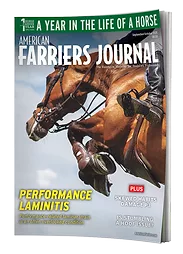At some point during the first couple of weeks I spent as an editor at American Farriers Journal, I asked a farrier if he could give me a simple definition of hoof balance. Over the years, I came to appreciate the fact that he kept a straight face as he answered me.
I had a lot to learn.
Over the next 13 years I did, indeed, learn a lot. But with every bit of knowledge came an increased awareness of how much more I didn’t know. My journey, on a smaller scope, was what every novice farrier faces when embarking on a hoof-care career.
During my tenure as an AFJ editor, I wrote close to 60 “Shoeing for a Living” articles that took me to 29 U.S. states and one Canadian province (I tried to work in Alaska and Hawaii, but Frank Lessiter always told me if anyone was going to those places, it would be him).
I got to watch farriers work on high-end racehorses at famous tracks, as well as on backyard horses that lived in tiny stables at the end of winding roads where the pavement had ended several miles back. I watched simple shoeing jobs (if there is such a thing) and complex therapeutic applications. Each was a learning experience.
Over the years, I came to appreciate how much courage was displayed by the men and women who granted me the privilege of riding along with them. All these farriers, veterinarians and other hoof-care professionals took a chance on me and on the American Farriers Journal to properly share their hoof-care work and put in on display for their peers. That’s not an easy thing to do. Even if the stories are accurate (and we checked and rechecked with the subjects to make sure they were), there’s always someone out there who’s ready to criticize or disagree with how the work was done.
The amount of learning I had to do to be able to write about hoof care pales, of course, in comparison to that needed by those who actually pick up a hoof, put a sharp knife to it and drive nails into its walls to attach shoes. Even when the basics are mastered, there’s so much more to learn.
I remember one farrier I rode along with saying that 3 to 5 years into his career, he started to feel confident in his abilities. A few years later, he came to realize how much he still didn’t know. At the time, he was almost afraid to shoe a horse. But he conquered the paralysis, kept learning and his career went on.
Sometime after that, I heard Mitch Taylor, the owner of the Kentucky Horseshoeing School, talk about getting beyond “cookie cutter horseshoeing.” This was the idea that one kind of shoeing fits any horse. Taylor indicated that there was nothing wrong with reaching “cookie cutter” status; indeed, it was a sign of progress for most novice shoers. It only became a problem if that’s where the progress ended.
I think what impressed me most about so many of the hoof-care professionals I got to work with was that progress never did stop. They attended clinics and educational sessions at events like the International Hoof-Care Summit, joined professional organizations such as the American Farrier’s Association and looked at every horse they shod as another learning opportunity.
A couple of times, I was privileged to have the late Red Renchin join me on “Shoeing for a Living” days. It was always a pleasure to hear the Hall of Fame farrier not only share his own knowledge but learn from our host.
At the inaugural International Hoof-Care Summit, the late Eddie Watson, who was well into his 80s, and who had shod thousands of horses in his career, told an audience, “I don’t know about you, but I’ve learned things this week that I’m going to use on Monday.” I was amazed at the time but now know I shouldn’t have been. Watson, like all the best farriers, just never stopped learning.
Looking back, I’d like to once again offer my thanks to the many hoof-care professionals who helped me share at least a little of their knowledge with others in the farrier community, who put up with my questions during ride alongs, interviews, long phone conversations and general bull sessions. It was always a pleasure — if often a bewildering one.
Oh, and if anyone comes up with that simple definition of balance, please let me know.
Professionals from around the world share their insights into the important milestones, innovations and the role American Farriers Journal has played over the last half-century.
Read essays from...
- Bob Smith
- Stuart Muir
- Mike Lessiter
- Heidi Larrabee
- Esco Buff
- Walt Taylor
- Simon Curtis
- Renate Weller
- Kit Miller
- Steve Kraus
- James Orsini
- Connor Sloman
- Cody Ovnicek
- Bill Everitt
- Mel Jones
- Dick Mansmann
- Brian Rusnak
- Pat Tearney
- Doug Butler
- Joanne Volkert
- Virgil Gluth
- Gretchen Cardoso
- Kim Otterson
- Brian Hyodo








